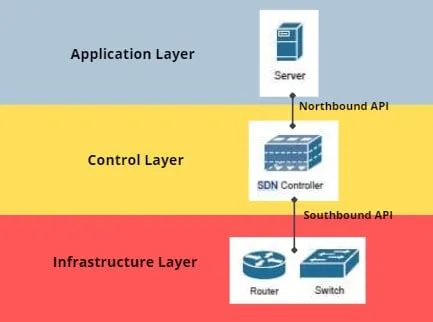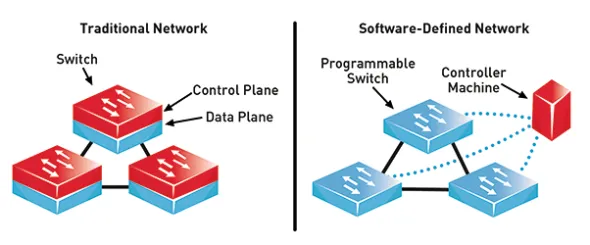The above image shows the difference between Traditional Network vs Software-Defined Network
When it comes to running a data center in today’s hyper-connected world — especially within Metanet’s interconnected ecosystem, which is essentially a giant, interconnected web of data centers — choosing the right networking approach is crucial. Among the many options out there, Software Defined Networking (SDN) providers stand out because they give you the flexibility to manage network services through software rather than hardware. But with so many choices available, how do you decide which SDN provider is the best fit for your data center?

Let me walk you through three top SDN providers , often called “NaaS” or Network-As-A-Service providers — Megaport, PacketFabric, and Epsilon Telecommunications — and then we’ll explore an alternative approach that might suit your needs: using fabric-based connectivity exchanges like Equinix Cloud Exchange, Coresite Open Cloud Exchange, and Digital Realty Interconnection Fabric.
Megaport: Agile and Scalable, But Is It Enough?
What Megaport Brings to the Table
Megaport is all about making connectivity simple and scalable. They’ve built a global network that covers over 600 locations across 24 countries, which is pretty impressive if you’re looking for extensive reach. One of the standout features here is their elastic connectivity, which allows you to scale your network bandwidth up or down depending on your needs. If your data traffic suddenly spikes, no worries — you can adjust on the fly.
They also offer seamless integration with major cloud providers like AWS, Microsoft Azure, and Google Cloud, making it easier to manage multi-cloud environments. And if you’re dealing with remote sites or branch offices, Megaport’s Virtual Edge (MVE) lets you connect these directly to the cloud, extending the network’s capabilities to the edge.
The Good and the Not-So-Good
What’s great about Megaport? First, its scalability is a real game-changer, especially if your network demands fluctuate frequently. Plus, the user-friendly interface makes it easy for even less tech-savvy teams to manage their network connections. And because it’s a pay-as-you-go model, you’re only billed for what you use — no unnecessary expenses.
But what’s the catch? Well, some users might find Megaport’s customization options a bit lacking. If you’re someone who likes to fine-tune every little detail of your network, you might feel a bit restricted. Also, depending on where you’re located, you could face latency issues, especially in areas where Megaport doesn’t have a strong presence.
PacketFabric: Automation and Performance, But Is It Worth the Price?
PacketFabric’s Strong Points
PacketFabric takes a slightly different approach, focusing heavily on automation and high-performance networking. If you’re in an industry where speed is crucial — think finance or media — PacketFabric’s high-capacity network could be a big win. They’ve built a powerful optical backbone that supports bandwidths up to 100 Gbps, ensuring you get the speed and performance you need.
One of PacketFabric’s standout features is their automated network provisioning. Instead of waiting days to set up a new connection, you can do it in minutes. They also offer Network as a Service (NaaS), which means you can consume network resources on-demand, with flexible billing options that can adapt to your needs.
The Ups and Downs
Why choose PacketFabric? If you’re looking to streamline your operations, the automation they offer is unbeatable. It reduces complexity and saves time, which is always a win. Plus, their high-performance network is ideal for businesses that need to move large amounts of data quickly and securely.
But what’s the downside? PacketFabric’s network isn’t as widespread as Megaport’s, so if you need global connectivity, you might find their coverage a bit limited. And let’s be honest, all that performance and automation comes at a cost — PacketFabric can be pricey, which might be a concern if you’re working with a tighter budget.
Epsilon Telecommunications: Intelligent Networking, But Is It Too Complex?
What Makes Epsilon Stand Out
This is one of my favorite network companies. They utilized many of the SDN ideas and concepts Metanet invented back in 2001 when we set up a research team bent on instant provisioning circuits over software-based networks to and from office buildings instantaneously through our own fiber using software controls long before it was coined “SDN”. This was a time when T1 circuits dominated the telecom landscape. The main difference is that Epsilon operates at the data center level instead of the user level. But they have done an amazing job with their service and software design.
Epsilon Telecommunications offers a blend of connectivity and intelligent network services. They’ve got a pretty broad reach, with over 220 points of presence (PoPs) worldwide, making them a strong contender for businesses with global operations. Their platform is packed with features like traffic optimization and real-time analytics, designed to help you get the most out of your network.
One of their unique offerings is the Interconnect Fabric, which simplifies the process of connecting to various carriers, cloud providers, and internet exchanges. If you’re looking for an all-in-one solution to manage your network, Epsilon has a lot to offer.
Pros and Cons
Why go with Epsilon? Their global reach and advanced network management features are real selling points. If you need to connect multiple international locations or optimize your network performance, Epsilon could be the way to go. They also offer robust security and compliance features, making them a strong choice for industries with strict regulations, like finance or healthcare.
However, what could be better? The platform’s complexity might be a barrier for some. If you’re not well-versed in network management, Epsilon’s advanced features might feel overwhelming. And then there’s the pricing structure — it can be a bit opaque, which makes it harder to predict and manage costs.
Another Approach: Fabric-Based Connectivity Exchanges
Now, what if you’re looking for an alternative to traditional SDN providers? Instead of going down the SDN route, you could consider using a fabric-based connectivity exchange. These platforms allow you to access various cloud providers and carriers through a single interface, making your life a lot easier.
Equinix Cloud Exchange (ECX)
Equinix Cloud Exchange is one of the most well-known options out there. It provides private, high-performance connections to over 2,000 partners, including cloud providers, networks, and service providers. If reliability is your top priority, Equinix’s reputation for uptime and security makes it a solid choice.
But, keep in mind that all this reliability and performance can come at a cost. ECX isn’t cheap, and managing multiple connections might require more expertise than you’re comfortable with.
Coresite Open Cloud Exchange
Coresite’s Open Cloud Exchange is another option, known for its secure and low-latency connections. It’s a great choice if you’re trying to blend your on-premises infrastructure with cloud resources. The platform is easy to use and emphasizes security, but its reach isn’t as extensive as some of the other options, which could be a drawback if you’re operating on a global scale.
Digital Realty Interconnection Fabric
Finally, there’s Digital Realty’s Interconnection Fabric, which offers a unified platform for connecting to cloud providers, networks, and service providers. It’s designed to integrate smoothly with your existing infrastructure, making it a good fit if you’re managing a hybrid or multi-cloud environment. The platform’s global reach is impressive, but some users might find it lacking in customization options.
So, Which Option Is Right for You?
Choosing the right SDN provider or fabric-based connectivity exchange comes down to your specific needs. If you need extensive global coverage and scalability, Megaport might be your best bet. If performance and automation are key, PacketFabric could be the way to go. For those who need advanced features and global interconnectivity, Epsilon Telecommunications offers a compelling option.
Alternatively, if you prefer a more streamlined, fabric-based approach to managing your connections, platforms like Equinix Cloud Exchange, Coresite Open Cloud Exchange, and Digital Realty Interconnection Fabric offer reliable and secure solutions, albeit with some trade-offs in cost and complexity.
Ultimately, the right choice depends on your organization’s size, geographic reach, and specific connectivity needs. Whatever you choose, make sure it aligns with your business objectives and future growth plans.


